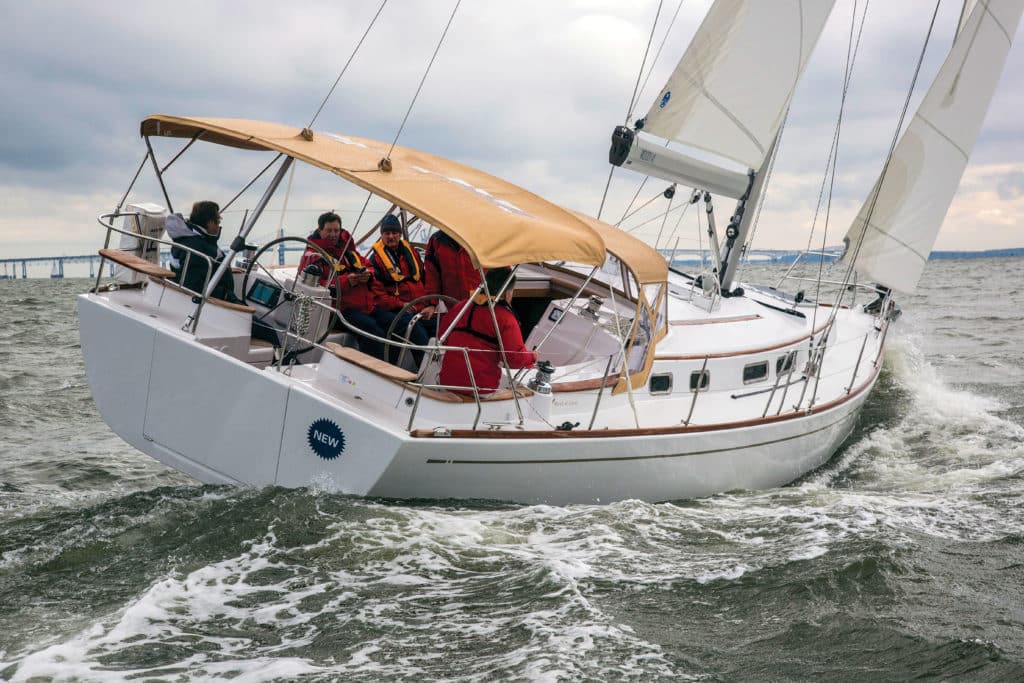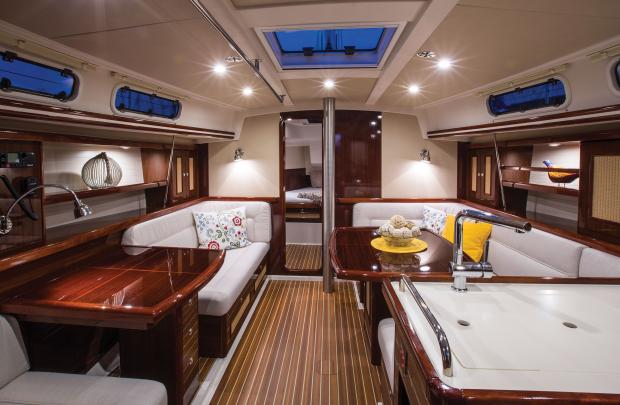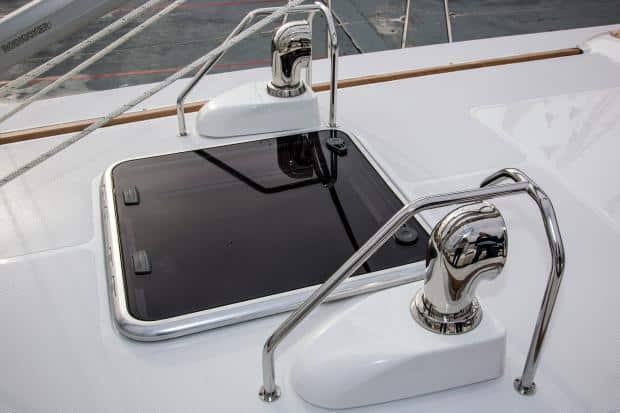
Moody Aft Cockpit 41
On a blustery fall day on Chesapeake Bay after the close of last year’s U.S. Sailboat Show in Annapolis, our Boat of the Year judges had the Moody Aft Cockpit 41 heeling smartly as it took the 15 knots of breeze just off the bow in stride. Compared to many of the sleek new performance cruisers we sailed that week, the Moody’s fit and finish seemed old fashioned — in a good way — with its long, low-slung trunk cabin and slightly overhung transom hinting at a lineage more akin to the classic plastics of yesteryear than its siblings in either the radical-looking Moody DS range or the minimalist Euro-style Hanses, all of which are built at the same yard in Greifswald, Germany.
But in fact, the 41 is a blend of old and new. Thoroughly modern are its nearly plumb bow, below-the-waterline hull form, cast-iron deep fin keel (shoal-draft lead-composite foil is available), and powerful sailing rig and self-tending jib (in-mast furling is optional, and was on the test boat). These all draw heavily from the work of the Hanse design team, which collaborated with longtime Moody designer Bill Dixon on this boat. Still, on deck and below, the look and feel of the 41 harken back to more traditional designs and to the days when the venerable Moody lineup of center-cockpit cruisers was built on England’s south coast.
While the BOTY team toiled on deck to size up the performance of what later in the week they’d deem to be the Best Midsize Cruiser, 40 to 44 feet, I stood below in the saloon, thoroughly enjoying the trappings of tradition: furniture situated in just the right places to provide handholds when and where needed; gleaming varnished mahogany woodwork set off by white panels and upholstery; light pouring in from overhead hatches and 10 inward-opening ports; fresh air from full-size dorades overhead; and devilish little details, such as the woven rattan insets on cupboard doors to keep storage areas well ventilated.

| |_Belowdecks, the saloon is quite traditional in both its layout and looks. The small table to port doubles as a nav station. _|
Later, when it was my turn to take command of the twin wheels, I found the Jefa steering to be silky smooth and the boat simple to handle as we tacked our way upwind with just a turn of the wheel. And as BOTY judge Tim Murphy noted, though the 41 has a fold-down swim platform and walk-through transom, when the platform’s raised, there’s a very secure feeling from having an actual coaming behind you; when steering, you don’t feel like you’re perched at the very aft end of the boat.
Forward of the helm stations, 55-inch benches to either side of the cockpit will let the crew lounge, though probably not stretch out and nap. Still, the seat backs are comfortable. In place of a cockpit table on the boat we sailed, a stainless-steel grab rail provided a solid brace when heeling or moving about.
The Moody 41 was described to us as “a passagemaker for couples,” and in that respect the builder hit the design brief spot on. The boat we sailed had a generously sized owner’s stateroom forward with a roomy V-berth and en suite head. There was just one double cabin aft to starboard and a portside head with separate shower at the foot of the companionway, behind which was an enormous storage locker. Twin aft cabins are an option, as are split berths in the forward cabin. Throughout, there were multiple storage lockers for stowing gear on extended voyages. The L-shaped galley, with fridge, freezer, and propane stove and oven, was equipped and sized with the serious chef in mind.
At its yard in Germany, Hanse builds boats in two ways. The majority of Hanses and Dehler yachts are laid up on a production line where boats advance from workstation to workstation at set times during the day.

| |Full-size dorade vents are fit with protective stainless-steel rails that also work as strong handholds forward of the mast. The vents, a rarity on new sailboats these days, bring in welcome fresh air both at anchor and under way.|
In a nearby custom shop, Moodys, the largest Hanses and Fjord powerboats are built in single stations, with work teams assigned as required. The result, said a Moody representative, is that about 25 percent more man-hours are required to build the AC 41, compared to a similar-size Hanse. This increase is reflected in both the finish and the price, which for the boat we sailed was $360,000 (a similar-size Hanse would be closer to $260,000).
The 41’s hull is composed of a cored fiberglass laminate sandwich, with an outer layer of gelcoat backed up by a layer of vinylester resin; Corecell foam is used below the waterline and balsa above. Decks are also cored with balsa, and solid aluminum plates are inserted in the laminate wherever hardware is to be mounted. Lewmar winches and a Furlex headsail furler come standard. In addition to the self-tacking jib, the 41 also sports inboard stays and outboard genoa tracks designed to handle up to about a 140 percent genoa on an optional second furler.
The Moody AC 41 is driven by a 40-horsepower Volvo engine and saildrive, which the judges felt was slightly underpowered. That said, they found the boat quite maneuverable when motoring and stable in even the sharpest turns. An optional 55-horsepower engine is available.
Said judge Alvah Simon in summarizing his view of the AC 41: “Bill Dixon designed a nice liquid hull, which made for a very nice sail today.” I’d eagerly second that statement. The Moody 41 was pretty to look at and quite comfortable under way.
This article first appeared in the December 2013 issue of Cruising World.








